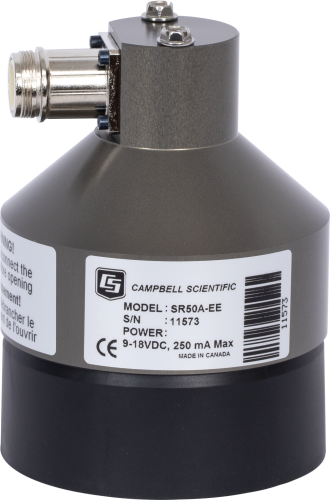This product has limited availability. Some accessories, replacement parts, or services may still be available when it is no longer available.

Corrosion-resistant chassis and transducer






Overview
Note: This product has limited availability. Please consider the SnowVue™10 Digital Snow-Depth Sensor for snow-depth measurements and the TempVue™20 Pt100 Digital Air Temperature Sensor or HygroVue™10 Digital Temperature and Relative Humidity Sensor with M12 Connector for air temperature measurements.
The SR50A-EE is an anodized version of Campbell Scientific's acoustic sensor for measuring the distance from the sensor to the snow surface. The sensor has been designed to operate in extreme environmental conditions where corrosion is a concern (such as coastal regions). The SR50A-EE features an aluminum body that has been treated with a Type III, hard-anodizing process (MIL-A-8625 Type III) that delivers best-in-class corrosion and wear resistance.
To properly calculate snow depth from the measured distance, an air temperature measurement is required to correct for variations of the speed of sound in air. This sensor is compatible with most Campbell Scientific data loggers.
Read MoreBenefits and Features
- Type III, hard-anodized body for increased resistance to corrosion and wear
- Open-faced transducer for increased corrosion resistance and decreased maintenance
- Non-contact method for determining snow depth
- Wide operating temperature range
- Designed for coastal or corrosive environments
- User-selectable options for output
- Uses a multiple echo processing algorithm to help ensure measurement reliability
- Compatible with most Campbell Scientific data loggers
Images



Detailed Description
The SR50A-EE was designed to meet the stringent requirements of measuring depths and uses a multiple echo processing algorithm to help ensure measurement reliability.
SDI-12, RS-232, and RS-485 output options are available for measuring the SR50A-EE. Campbell Scientific’s MD485 interface can be used to connect one or more SR50A-EE sensors in RS-485 mode to an RS-232 device. This can be useful for sensors that require lead lengths that exceed the limits of either RS-232 or SDI-12 communications. The SR50AH-L is available with a heater option for locations where rime ice is a problem.
Compatibility
Note: The following shows notable compatibility information. It is not a comprehensive list of all compatible or incompatible products.
Data Loggers
| Product | Compatible | Note |
|---|---|---|
| CR1000 (retired) | SDI-12 and RS-232. For RS-485, requires an MD485 interface or similar RS-485 to RS-232 interface. | |
| CR1000X (retired) | SDI-12 and RS-232. For RS-485, requires an MD485 interface or similar RS-485 to RS-232 interface. | |
| CR300 (retired) | SDI-12 and RS-232. For RS-485, requires an MD485 interface or similar RS-485 to RS-232 interface. | |
| CR3000 (retired) | SDI-12 and RS-232. For RS-485, requires an MD485 interface or similar RS-485 to RS-232 interface. | |
| CR310 | SDI-12 and RS-232. For RS-485, requires an MD485 interface or similar RS-485 to RS-232 interface. | |
| CR350 | SDI-12 and RS-232. For RS-485, requires an MD485 interface or similar RS-485 to RS-232 interface. | |
| CR6 | SDI-12, RS-232, and RS-485 | |
| CR800 (retired) | SDI-12 and RS-232. For RS-485, requires an MD485 interface or similar RS-485 to RS-232 interface. | |
| CR850 (retired) | SDI-12 and RS-232. For RS-485, requires an MD485 interface or similar RS-485 to RS-232 interface. |
Distributed Data Acquisition
| Product | Compatible | Note |
|---|---|---|
| Granite 6 (retired) | SDI-12 and RS-232. For RS-485, requires an MD485 interface or similar RS-485 to RS-232 interface. |
Additional Compatibility Information
Data Logger Considerations
One single-ended channel per probe is required; an excitation channel can be shared by several probes.
Specifications
| Measurement Time | < 1.0 s |
| Output Options | SDI-12 version 1.3, RS-232, RS-485 (output options selected by configuring internal jumpers) |
| Baud Rates | 1200 to 38400 bps (RS-232, RS-485 modes) |
| Power Requirements | 9 to 18 Vdc (typically powered by data logger’s 12 Vdc power supply) |
| Measurement Range | 0.5 to 10 m (1.6 to 32.8 ft) |
| Beam Acceptance | ~30° |
| Resolution | 0.25 mm (0.01 in.) |
| Accuracy | ±1 cm (0.4 in.) or 0.4% of distance to target (whichever is greatest). Requires external temperature compensation. |
| Operating Temperature Range | -45° to +50°C |
| Compliance | CE compliant |
| Length | 10.1 cm (4.0 in.) |
| Diameter | 7.5 cm (3 in.) |
| Weight | 362.9 g (12.8 oz) without cable |
| Cable Weight | 250 g (8.2 oz) for a 4.57-m (15-ft) cable |
Maximum Cable Length |
|
| -NOTE- | Cable lengths greater than 60 m require a heavier gage wire if the power supply drops below 11 Vdc. |
| SDI-12 | 60 m (200 ft) |
| RS-232 |
60 m (200 ft) Baud rates ≤ 9600 bps |
| RS-485 | 300 m (984 ft) |
Power Consumption |
|
| Active | 250 mA (typical) |
| Quiescent SDI-12 Mode | < 1.0 mA |
| Quiescent RS-232/RS-485 Modes |
|
Downloads
SR50A example programs v.1 (11 kB) 01-22-2020
CR6 and CR1000X programs that directly read each type of SR50A output (SDI-12, RS-232, RS-485), and a CR1000 program that reads the RS-485 output using an MD485 Multidrop interface. A 107 sensor provides the temperature measurement needed for temperature compensation. The programs use the data filtering method described in the manual.
Privacy Policy Update
We've updated our privacy policy. Learn More
Cookie Consent
Update your cookie preferences. Update Cookie Preferences



